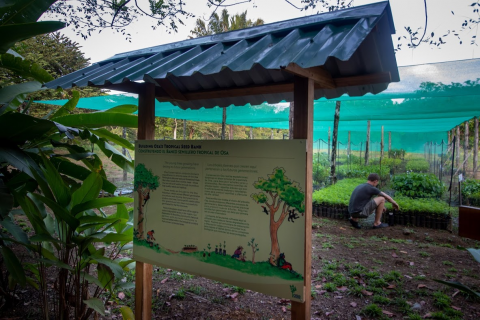
Costa Rica’s newest arboretum (website here) is a combination of innovative conservation technology and cutting-edge botanical research. The Osa Arboretum protects more than 300 native, rare, endemic and threatened tree species in the Osa Peninsula, a Costa Rican biodiversity hotspot. It aims to be one of the largest arboretums in Central America, with a trail network that spans more than 625 acres across old growth, secondary, mangrove and coastal forests. The arboretum includes endangered tree species such as the Paramachaerium gruberi, and Caryocar costaricense and rarities including the so-called living fossil Pleodendron costaricense.
The Osa Arboretum is an ideal location for research, education, and tourism on tropical botany and conservation. Scientists, students, and visitors from around the world are invited to visit the arboretum, engage with Osa’s spectacular botanical biodiversity, and see native wildlife in their natural habitat (click here for information for reservations). The Osa Arboretum features the region's first nursery focused on the propagation of endemic and endangered trees, an innovative restoration experiment to kick-start rainforest succession, and a regenerative agroecological farm. As visitors explore our trails, they will learn about the natural history, conservation status, and cultural significance of over 300 species of native plants through bilingual interpretive panels and QR codes. For those interested in learning about Osa’s biodiversity from the comfort of home, the Osa Arboretum website (link here) includes maps, bilingual descriptions and audio recordings of the species, and other multimedia resources.
The Osa Arboretum is an initiative of Osa Conservation (website here), a non-profit organization that has been protecting Osa’s biodiversity since 2003. In developing the arboretum, Osa Conservation’s team of botanists and restoration ecologists conducted expeditions into remote protected areas to research the ecology and conservation status of endangered and endemic trees. During the expeditions, over 600 species of trees belonging to 78 botanical families were found. Of these, 38 species are listed on the IUCN Red List under a threatened status. The team updated the IUCN Red List status of 14 native trees. Osa Conservation strives to facilitate connectivity between protected areas in the region through restoration and rewilding with local communities, and has planted over 350,000 trees.
The Osa Arboretum is a member of Botanic Gardens Conservation International (BGCI). It has ArbNet Level 1 Certification and is in process of acquiring Level 2 Certification.
-- by Hilary Brumberg, Lowlands Ridge to Reef Program Manager, Osa Conservation
Key media:
- Osa Arboretum website, including Plant Finder, bilingual interpretive panels and videos: https://osa-arboretum.org/
- Osa Arboretum video: https://www.youtube.com/watch?v=QXP2QqC--xk&t=2s
- Listen to the Trees video, on Osa Conservation’s efforts to conserve rare and endangered mega-trees: https://www.youtube.com/watch?v=Ceo4XhFidMI&t=1s
- Adopt-a-Tree Campaign: Support endangered and endemic trees of Osa through adopting a tree: https://pages.donately.com/osaconservation-8514/campaign/cmp_9abcbab0ed14
Figure 1. Newly-installed interpretive sign about building Osa’s tropical seed bank outside of our native tree nursery. Interpretive signs were installed throughout the Osa Arboretum. Photo: Lucy Kleiner
Figure 2. Osa Conservation team member hand pollinates vanilla next to interpretive sign designed to teach visitors about the importance of vanilla and agroforestry systems. Photo: Lucy Kleiner
Figure 3. Costa Rican botanist Leonardo Alvarez prepares botanical sample during remote botanic expedition in Corcovado National Park to deposit in the National Museum of Costa Rica. Photo: Hilary Brumberg
Figure 4: Local Junior Park Rangers plant native tree in riparian restoration project in Osa Biological Corridor.

